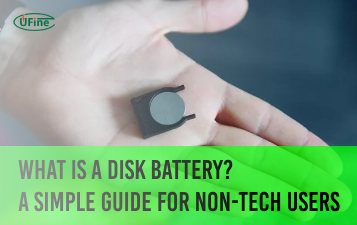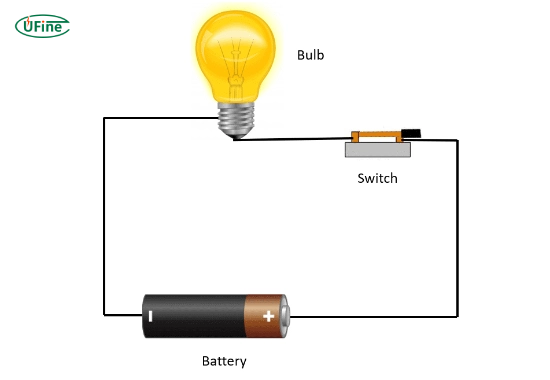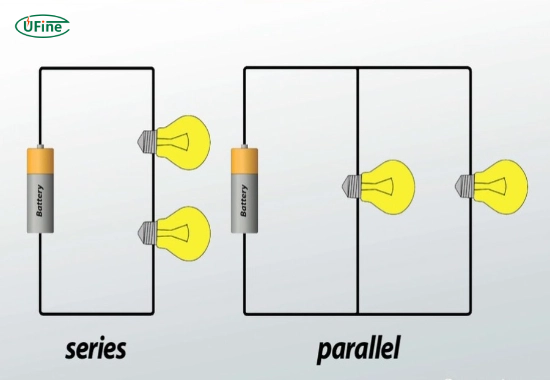Battery circuits form the backbone of modern electronics, powering devices that have become integral to our daily lives. These intricate networks of components facilitate the controlled flow of electrical energy from a power source to a load, enabling the functionality of numerous electronic devices. In this comprehensive guide, we delve into the intricate workings of battery circuits, exploring their fundamentals, working principles, types, maintenance, and troubleshooting techniques.
Part 1. Basics of a battery circuit
A battery circuit is a fundamental setup enabling the flow of electrical energy from a power source (the battery) to a load, facilitated by conductive elements and various components. This arrangement is pivotal in numerous electronic devices and systems. Let’s dissect its key constituents:
1. Battery: The Power Source
A battery is a self-contained electrochemical cell that converts chemical energy into electrical energy. It comprises one or multiple electrochemical cells connected in series or parallel. Each cell contains a positive electrode (cathode), a negative electrode (anode), and an electrolyte facilitating ion movement between electrodes during the electrochemical reactions.
2. Load: Utilizing Electrical Energy
The load is any component or device that consumes electrical energy to perform a specific function. It could be a light bulb, a motor, a microcontroller, or any electrical device requiring power to operate. The load is connected to the battery circuit to receive the electrical energy generated.
3. Conductive Elements: Wiring and Connectors
Conductors like wires, connectors, and traces on a circuit board serve as pathways for the electrical current to flow from the battery to the load and back. These elements ensure a low-resistance path for the electricity to travel, minimizing energy loss along the circuit.
4. Switches and Controls
Often incorporated into the battery circuit are switches and control mechanisms. Switches enable the user to control the flow of electricity, allowing for the activation or deactivation of the circuit. Control devices, such as resistors or diodes, can regulate the current or voltage within the circuit.
5. Protective Components
Certain components, like fuses or circuit breakers, are included to protect the circuit from overcurrent or short circuits. These elements safeguard both the battery and connected devices from potential damage due to unexpected surges in current.
6. Monitoring and Measurement Devices
In more complex battery circuits, monitoring devices like voltmeters, ammeters, or multimeters might be integrated. These instruments enable users to measure voltage, current, and other electrical parameters within the circuit, providing crucial diagnostic information about its performance.
Part 2. Working principles of a battery circuit
Battery Circuit Operation
In the intricate operation of a battery circuit, several key processes unfold to facilitate the flow of electricity:
Electron Movement
- Electrons, negatively charged particles, move from the negative terminal of the battery to the positive terminal.This movement is induced by the potential difference created by the chemical reactions within the battery.
Conductive Pathways
- Conductive elements like wires or traces on a circuit board form pathways for electrons to travel.
- These pathways offer low-resistance routes, allowing electrons to flow efficiently.
Interaction with Load
- Electrons encounter the load, which could be a light bulb, motor, or any device within the circuit.
- The transfer of energy from electrons to the load powers the functionality of the connected device.
Continuous Electron Flow
- The continuous movement of electrons along the conductive path establishes an electric current.
- The rate of this flow determines the current strength, measured in amperes (A).
Completing the Circuit
- The circuit’s loop or closed pathway ensures a continuous flow of electrons.
- It allows electrons to travel from the negative terminal of the battery, through the load, and back to the positive terminal, completing the cycle.
Role of Chemical Reactions
- Within the battery, chemical reactions drive the movement of electrons.These reactions generate an electrical potential difference, establishing the driving force for electron flow.
Voltage, Current, and Resistance in Battery Circuits
Voltage
Definition: Voltage represents the electrical potential difference between two points in a circuit, measured in volts (V).
Impact on Circuits:
- Higher voltage batteries provide more potential energy per charge unit, influencing the overall power output.
- Voltage determines the force that drives electrons through the circuit.
Current
Definition: Current is the flow of electric charge, measured in amperes (A), indicating the rate of electron movement.
Role in Circuits:
- Current determines the intensity of the electron flow, impacting device functionality.
- Higher current levels power devices more robustly, but excessive currents might damage components.
Resistance
Definition: Resistance is the opposition to the flow of electrons, measured in ohms (Ω).
Effects on Circuits:
- Increased resistance restricts the flow of current, affecting the overall performance of the circuit.
- Components like resistors or conductive materials contribute to the circuit’s total resistance.
Ohm’s Law
Relationship Between Voltage, Current, and Resistance:
- Ohm’s Law (V = IR) elucidates the relationship between voltage (V), current (I), and resistance (R) in circuits.
- It indicates that voltage equals current multiplied by resistance, providing a foundational equation in circuit analysis.
Power Dissipation
Effect of Voltage and Resistance:
- The interaction of voltage and resistance determines the amount of power dissipated in a circuit.
- Higher voltages across resistive elements lead to increased power dissipation, which can affect component lifespan.
Part 3. Types of battery circuits
Series Circuits
A series circuit involves connecting multiple batteries or components in a linear fashion, end-to-end, forming a singular pathway for the flow of current. In a series configuration, the positive terminal of one battery connects to the negative terminal of the next, creating a continuous chain. Components or batteries in a series circuit share the same current but experience varying voltages based on the number of elements in the series.
Characteristics and Advantages:
- Constant Current Flow: Current remains constant throughout the circuit as it passes through each connected element.
- Cumulative Voltage: The total voltage across the series circuit is the sum of the individual voltages of each component, providing a higher overall voltage output.
- Uniform Current Distribution: The same current passes through each component, ensuring uniform operation.
- Balancing Voltage: Balancing cells in series can be advantageous for applications requiring higher voltage but lower current.
Parallel Circuits
A parallel circuit involves connecting batteries or components side-by-side, where each component forms an individual path for the flow of current. In a parallel arrangement, the positive terminals of all components or batteries connect together, as do the negative terminals. Each component or battery in a parallel circuit has its own branch and receives the full voltage of the source.
Characteristics and Advantages:
- Varied Current Paths: Current splits among the parallel branches, enabling individual paths for different components.
- Constant Voltage: All components experience the same voltage as the source, ensuring consistent performance.
- Redundancy and Reliability: If one component fails, others continue to operate independently, enhancing system reliability.
- Increased Current Capacity: Parallel connections allow for greater overall current capacity, advantageous for high-power applications.
Part 4. Circuit maintenance and troubleshooting
Maintenance Practices for Battery Circuits
Regular Inspections:
- Conduct routine checks on battery terminals, ensuring they are clean and free from corrosion.
- Examine wiring and connections for signs of wear or damage, repairing or replacing as needed.
Monitoring Voltage Levels:
- Use voltmeters to measure battery voltage periodically, ensuring they remain within optimal ranges.
- Address any significant fluctuations or drops in voltage promptly, as they can indicate underlying issues.
Cleaning and Care:
- Clean battery terminals and connections using a solution of baking soda and water to remove corrosion.
- Keep batteries in a clean and dry environment to prevent contamination or moisture damage.
Proper Charging Practices:
- Follow manufacturer guidelines for charging batteries, avoiding overcharging or undercharging.
- Use compatible chargers and adhere to recommended charging durations to maintain battery health.
Troubleshooting Techniques
Identifying Voltage Issues:
- Check for voltage drops across the circuit using a multimeter to pinpoint potential areas of concern.
- Test individual components to assess if any are causing a significant voltage drop or irregularities.
Detecting Current Problems:
- Measure current flow through the circuit to identify abnormalities or sudden changes.
- Look for components drawing excessive current, which may indicate faults or malfunctions.
Addressing Resistance Problems:
- Test resistance across various parts of the circuit to detect high-resistance areas.
- Investigate components or connections causing increased resistance, leading to inefficiencies.
Isolating Component Failures:
- Use systematic testing methods to isolate and identify malfunctioning components.
- Replace or repair faulty elements, ensuring the circuit functions optimally.
Part 5. FAQs
-
What is a battery eliminator circuit?
A battery eliminator circuit replaces the need for batteries by providing a constant DC voltage source to power a device or circuit. It typically uses a power supply to simulate the output of a battery. -
How does a battery supply electrical energy to a circuit?
A battery operates by converting chemical energy into electrical energy. When connected in a circuit, the chemical reactions within the battery release electrons, creating an electric current that flows through the circuit. -
Why is thick wire used for the battery starter circuit?
Thick wires are used in battery starter circuits to handle high currents without overheating. The thick gauge reduces resistance, ensuring efficient power transfer from the battery to start the vehicle. -
Can a short circuit damage a battery?
Yes, a short circuit can damage a battery by causing excessive current flow. It generates heat, potentially leading to electrolyte leakage, internal damage, or even rupture in extreme cases. -
How do batteries produce a voltage difference in a circuit?
Batteries create a voltage difference by having two terminals with different electric potentials due to chemical reactions. When connected in a circuit, electrons flow from the negative terminal (anode) to the positive terminal (cathode), creating a potential difference or voltage.
Related Tags:
More Articles

What Is a Disk Battery? A Simple Guide for Non-Tech Users
A disk battery is a small, round cell used in watches, remotes, and other electronic devices. It delivers steady power for compact, low-drain devices.
What Battery Powers a Space Heater?
Discover the type of battery that powers space heaters and learn how to choose the right one for efficient heating in your home or office.
What Is an LR14 Battery? Learn About This C-Size Cell
The LR14 battery, also known as a C battery, delivers steady power. Learn its specs, uses, lifespan, and how it compares to other battery types.
Watch Battery Dimensions Chart: Sizes, Voltages, and Equivalents Explained
Understanding watch battery dimensions helps you choose the right size, voltage, and equivalent model to keep your watch running safely and smoothly.
How Long Can You Rely on Battery-Powered Generators?
Discover battery generator runtime & lifespan factors. Learn how to maximize performance and choose the right power solution.





